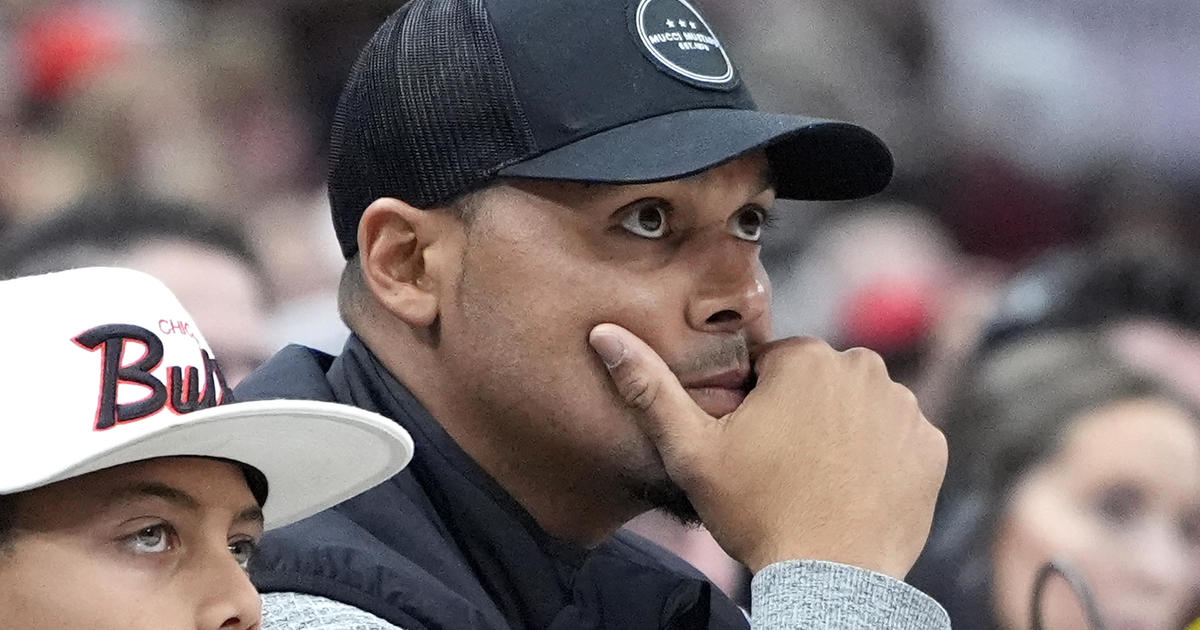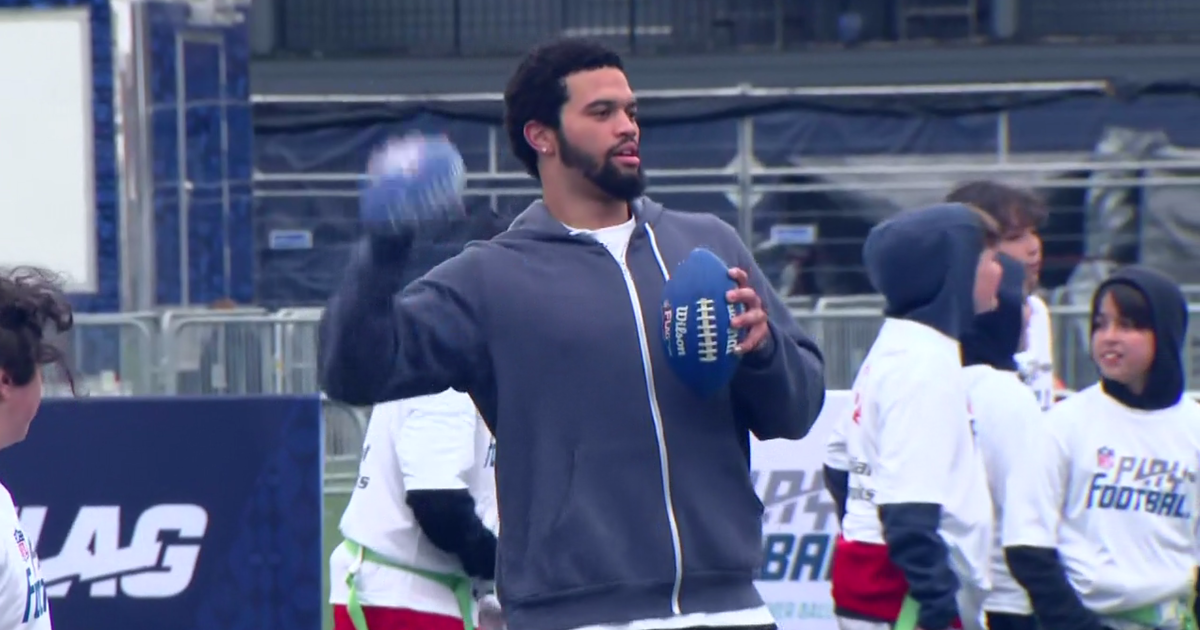Hoge's Bears Offseason Notebook No. 14: A Football Glossary
By Adam Hoge-
(CBS) — We're fast approaching the rare dead spot on the NFL calendar between mini-camps and training camp, which means it's a great time to brush up on your football vernacular for the upcoming season.
The following are a number of football terms you might hear a lot during the Bears' season -- especially with the team hinting that it will feature multiple looks on a revamped defense -- but might not fully understand:
Helpful terms
Shade tackle vs. under tackle - Bears general manager Phil Emery often uses these terms to identify his defensive tackles, and they're really just another way of saying nose tackle and three-technique. The nose is sometimes referred to as a "shade" because that player is often shaded to either shoulder of the opposing center. The under tackle refers to a three-technique lined up on the split end side of the formation (away from the tight end). This is part of an "under" front, which we'll address shortly.
Three-technique - This position is becoming as well known as "linebacker" or "cornerback" these days, but some football fans still might not understand what it means. The three-technique refers to an actual defensive linemen technique which calls for a defensive tackle to line up on the outside shoulder of an opposing offensive guard. The alignment techniques for defensive linemen are numbered inside-out from 0-9, with a zero technique head up on the center and the nine-technique lined up wide to the outside of a tight end. Dan Durkin did a great job detailing the techniques here in a piece I highly recommend you bookmark.
Over vs. under fronts - These terms refer to the defensive fronts based on the alignment of an opposing tight end. A defense is in an "under" front if the three-technique is lined up on the open side of the formation (away from the tight end) and the nose tackle is shaded over the center to the closed side of the formation (the side with the tight end). A defense is in an "over" front if the three-technique is lined up on the closed side of the formation (the side with the tight end) and the nose tackle is shaded over the center to the open side of the formation (away from the tight end).
11 personnel - Also known as "posse" personnel, this refers to having one back and one tight end on the field, which means an offense is also deploying three wide receivers. Numbers like "11", "21" and "22" are typically the first thing both offenses and defenses identify before making their respective calls. "22" may be called out as one number, but it's really referring to two numbers: the number of running backs and the number of tight ends on the field. It's a simple game of math. If an offense deploys "21" personnel, there are two backs and one tight end. With a quarterback and five offensive linemen also on the field, that means there is room for two wide receivers. In "22" personnel, there would only be room for one wideout on the field. By calling out the number, offensive players immediately know whether they are supposed to be on the field. The same goes for the defense. As soon as a defensive coordinator identifies the opposing offensive personnel, he knows how many defensive backs to deploy on his side of the ball.
Slot corner vs. nickel corner - First off, "nickel" refers to the defensive personnel in which five defensive backs are on the field. Typically, teams use nickel personnel on passing downs, but with the rise in "11" personnel, nickel has been used more on all downs. And because teams will run the football out of "11" personnel, the cornerback who lines up in the slot must be able to stop the run. In many cases, the nickel corner (third cornerback deployed only in nickel personnel) is also the slot corner, however, as we have seen during Bears OTAs, this is not always case. In the Bears' first open OTA practice, rookie Kyle Fuller was deployed as the nickel corner, but he lined up outside when he came onto the field, and Tim Jennings moved inside to the slot corner.
Inverted safety - You may have heard Emery refer to Fuller as an "inverted safety" when he described Fuller's role in a game against Georgia Tech. This refers to a safety playing in the box, close to the line of scrimmage, often rushing a gap. Essentially, an inverted safety is used as an extra linebacker.
Zero blitz - One might see this term and assume it means no one is blitzing, but it's really the opposite. The "zero" refers to Cover-0, which means the secondary is in man coverage across the board as the rest of the defense rushes the quarterback. Zero blitz can also be referred to as an all-out blitz.
Mesh point - This might be a newer term to Bears fans, as it refers to the point where the quarterback and running back meet on a handoff or fake handoff. In Marc Trestman's offense, the Bears use a lot of packaged plays, which allows the quarterback to decide to either execute a run play or a pass play based on what the defense shows. The "mesh point" then becomes an important part of the play, because it's where the quarterback must make up his mind, if he hasn't already. For defenses, if they can attack the mesh point, they can frequently cause fumbles at the mesh point.
Sam, Mike and Will - They might be your brothers' names, but they also refer to the three linebackers on the field. Sam = strong-side linebacker, Mike = middle linebacker and Will = weak-side linebacker. When it comes to code names in football, the first letter often means something and in many cases the second letter does, too. For instance, "Smash" calls for the Sam and Mike linebackers to blitz.
The Meaning Of Clausen
It seems most Bears fans were caught off guard by the signing of quarterback Jimmy Clausen over the weekend, mainly because it means the team now has five quarterbacks on the roster. And it's fair to wonder this: If the Bears are as high on Jordan Palmer, David Fales and Jerrod Johnson as they say they are, then why add Clausen?
Here's the thing. Do you know how many combined passes Palmer, Fales and Johnson have thrown in the NFL? Just 15. That's just the first half of one game for Jay Cutler.
In fairness, Clausen hasn't thrown a pass in the NFL since 2010, but at least he started 10 games and attempted 299 passes that season. The signing doesn't change the fact that Palmer is still the front-runner to win the job, but it gives him at least a little bit more competition than a sixth-round rookie and a former undrafted free agent.
First-timer
Did you know that this is the first time in guard Kyle Long's life that he has gone through an actual football offseason program?
When Long transferred to Oregon from Saddleback Community College, he was unable to enroll until the fall, which kept him out of the Ducks' spring and summer programs. Then, on top of the usual abbreviated work NFL rookies get after being drafted, the timing of Oregon's graduation prevented him from participating in the Bears' OTAs last year. Now free from all the rules that kept him away from his teams and facilities, Long has been at Halas Hall since April when the permitted team offseason program began.
So if Long turned himself into a first-round pick and Pro Bowler without the offseason help before, what's he going to do this year?
Extra Point
You may have noticed that I skipped the Twitter questions this week. That's mainly because too many of the questions were in this format: "How has ______ been looking in OTAs?" The answer to that every time is: "He looks like a football player running around in shorts."
I don't mean to be brash, but the reality is that it would be unfair for me to start evaluating players when they aren't even in pads. Teams have a hard enough time evaluating players this time of year, but at least they have the coaches' tape of practice that they can go back and watch. And even with that, they're mainly looking at how players are adapting to new techniques, assignments, etc. — in other words, things that are discussed in the meeting rooms that we don't have access to. This is the time of year where we diagnosis changes from last year, either schematically or with specific players. Training camp and the preseason is when we can evaluate the success of those changes.
Adam Hoge covers the Bears for CBSChicago.com and is a frequent contributor to 670 The Score. Follow him on Twitter at @AdamHoge.



